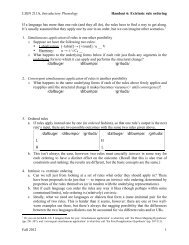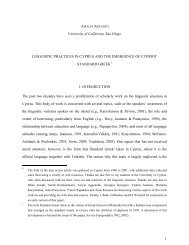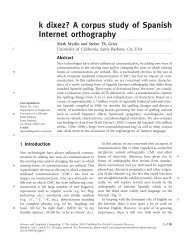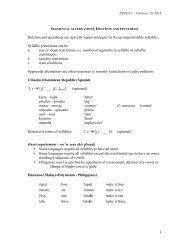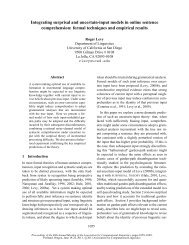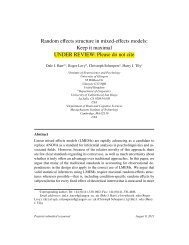Vowel and consonants beyond English
Vowel and consonants beyond English
Vowel and consonants beyond English
Create successful ePaper yourself
Turn your PDF publications into a flip-book with our unique Google optimized e-Paper software.
<strong>Vowel</strong> <strong>and</strong> <strong>consonants</strong><br />
<strong>beyond</strong> <strong>English</strong><br />
LIGN 210<br />
Spring Quarter 2009<br />
Flapping<br />
In American <strong>English</strong>, [t] is pronounced as an<br />
alveolar tap [ɾ] when found between a stressed<br />
vowel <strong>and</strong> an unstressed vowel, e.g. city, potato,<br />
Ottawa.<br />
Nasal + stop sequences can also be pronounced<br />
like flaps if the stress conditions are also met, e.g.<br />
winter.<br />
A flap (or tap) is a single flick of the tongue against<br />
the alveolar ridge; this is a very short, ballistic<br />
movement (i.e. this is not a controlled closure, but<br />
really a short tap).<br />
*In many American publications D is used instead of [ɾ]<br />
Trills<br />
Trills involve the vibration of an articulator (lips,<br />
tongue tip, or uvula) by a current of air<br />
Trills can only be produced under the right<br />
aerodynamic conditions<br />
Although they can be sustained, they typically<br />
have no more than 2-5 periods<br />
[ʙ] = voiced bilabial trill (Kele)<br />
[r] = voiced alveolar trill (Spanish ‘double r’)<br />
[ʀ] = voiced uvular trill (Swedish, some varieties of<br />
French <strong>and</strong> German)<br />
1<br />
3<br />
5<br />
What we will talk about<br />
Taps, Flaps <strong>and</strong> Trills<br />
Types of <strong>consonants</strong> attested in each place<br />
of articulation<br />
Double <strong>and</strong> secondary articulations<br />
<strong>Vowel</strong>s <strong>beyond</strong> <strong>English</strong><br />
A flap (from Catford 1994)<br />
Taps <strong>and</strong> Flaps<br />
Tap – the tip of the tongue hits the roof of the<br />
mouth once (the movement is up-down) e.g. very<br />
Flap – the tip of the tongue is curled up like a<br />
retroflex before hitting the roof of the mouth (the<br />
movement is back-to-front), e.g. dirty<br />
[ɾ] = voiced alveolar tap<br />
[ɻ ] = voiced retroflex flap<br />
Tap <strong>and</strong> trill example<br />
2<br />
4<br />
6<br />
1
Rhotic <strong>consonants</strong><br />
Dental/alveolar trill [r] Spanish<br />
Dental/alveolar tap/flap [ɾ] Spanish<br />
Dental/alveolar approximant [ɹ] <strong>English</strong><br />
Alveolar (laminal) fricative trill [r̝] Czech<br />
Dental/alveolar lateral tap/flap [ɺ] Japanese<br />
Retroflex tap/flap [ɽ] Tamil<br />
Retroflex approximant [ɻ] <strong>English</strong><br />
Uvular trill [ʀ] French<br />
Uvular approximant [ʁ] French<br />
It is not clear what makes rhotics a category<br />
Laterals <strong>and</strong> Place of Articulation<br />
Laterals may be produced at various places of<br />
articulation: dental, alveolar, retroflex, palatal, or<br />
velar:<br />
[l̪] = voiced dental lateral approximant (Malayalam)<br />
[l] = voiced alveolar lateral approximant (<strong>English</strong>)<br />
[ɭ] = voiced retroflex lateral approximant (Malayalam)<br />
[ʎ] = voiced palatal lateral approximant (Italian, Spanish,<br />
Greek)<br />
[ʟ] = voiced velar lateral approximant (Melpa - Papua<br />
New Guinea)<br />
Labials - Bilabials<br />
<strong>English</strong> has only bilabial stops [m p b].<br />
Bilabial fricatives are also possible.<br />
Spanish has a voiced bilabial fricative [β]:<br />
cabo [kaβo]<br />
Japanese has a voiceless bilabial fricative [ɸ].<br />
Ewe (spoken in Ghana <strong>and</strong> Togo) has both<br />
voiceless <strong>and</strong> voiced bilabial fricatives: [ɸ]<br />
<strong>and</strong> [β].<br />
7<br />
9<br />
11<br />
Laterals <strong>and</strong> Manner of Articulation<br />
<strong>English</strong> has only one lateral, the alveolar lateral<br />
approximant [l].<br />
Laterals can also be stops, fricatives or flaps<br />
[ɬ] = voiceless alveolar lateral fricative<br />
[ɮ] = voiced alveolar lateral fricative<br />
Welsh has a voiceless alveolar lateral fricative: [ɬ].<br />
Zulu has [l] [ɬ] <strong>and</strong> [ɮ].<br />
It is also possible to make a voiced alveolar (or<br />
retroflex) lateral flap, [ɺ], as in Japanese.<br />
Types of <strong>consonants</strong> attested in each<br />
place of articulation<br />
Labials - Labiodentals<br />
<strong>English</strong> has labiodental fricatives: [f v].<br />
It also has a labiodental nasal, [ɱ], as an<br />
alternate of /m/ in words like ‘infamous’.<br />
German has a voiceless labial affricate, [pf], as in<br />
the word for horse ‘pferd’.<br />
8<br />
10<br />
12<br />
2
Coronals – Alveolars<br />
<strong>English</strong> has alveolar stops: [t d n].<br />
It is also possible to have alveolar affricates.<br />
German has a voiceless alveolar affricate [ts].<br />
Canadian French <strong>and</strong> Greek have both voiced <strong>and</strong><br />
voiceless alveolar affricates [ts] <strong>and</strong> [dz]; e.g.<br />
(GR) [tsai] tea, [dzaci] fireplace.<br />
Coronals - Postalveolar<br />
<strong>English</strong> has postalveolar fricatives <strong>and</strong><br />
affricates: [ʃ ʒtʃ dʒ].<br />
Polish has alveolo-palatal fricatives:<br />
[ɕ] = voiceless alveolo-palatal fricative<br />
[ʑ] = voiced alveolo-palatal fricative<br />
The alveolo-palatal <strong>consonants</strong> have greater raising<br />
of the front of the tongue than the postalveolars.<br />
Coronals – Palatals<br />
<strong>English</strong> has only one palatal, the approximant [ j ].<br />
Other languages have palatal stops, fricatives, nasals <strong>and</strong><br />
liquids.<br />
Akan, Greek, <strong>and</strong> Hungarian have voiceless <strong>and</strong> voiced<br />
palatal stops: [c ɟ].<br />
German has a voiceless palatal fricative: [ç].<br />
Greek has both voiceless <strong>and</strong> voiced palatal fricatives<br />
<strong>and</strong> a lateral: [ç ʝʎ].<br />
Italian, Spanish, French, Hungarian, <strong>and</strong> Greek have a<br />
palatal nasal: [ɲ].<br />
13<br />
15<br />
17<br />
Coronals – Alveolars<br />
Consonants can be articulated forward of the<br />
alveolar ridge (dental) or further back (behind the<br />
center of the alveolar ridge).<br />
Spanish has dental stops: [t̪ d̪ n̪].<br />
Hindi <strong>and</strong> Sindhi have retracted alveolar<br />
affricates: [t̠ʃ] [t̠ʃ h ] [d̠ʒ] <strong>and</strong> [d̠ʒ h ] (these are<br />
similar to the <strong>English</strong> postalveolar affricates).<br />
Coronals - Retroflex<br />
Retroflex sounds are produced with the tip of the<br />
tongue curled up <strong>and</strong> back to touch the area behind<br />
the alveolar ridge.<br />
Retroflex stops, fricatives, <strong>and</strong> nasals are found in<br />
many languages of India, such as Malayalam.<br />
Some Dravidian languages of South India, like<br />
Malayalam, contrast dental, alveolar, <strong>and</strong> retroflex<br />
stops.<br />
Link to movie<br />
The Articulation of Palatals<br />
From Ladefoged, 2001<br />
Hungarian palatals<br />
14<br />
16<br />
18<br />
3
Variation in dental/alveolar articulations<br />
From Catford 1994<br />
Nunggubuyu Coronals<br />
From<br />
Ladefoged,<br />
2001<br />
Retroflex vs. Rectracted Alveolar<br />
19<br />
21<br />
From<br />
Ladefoged,<br />
2001<br />
23<br />
How many coronals can a language have?<br />
Most often, two to three coronal places of articulation are<br />
used by a given language; e.g. some Dravidian languages of<br />
South India, like Malayalam, contrast dental, alveolar, <strong>and</strong><br />
retroflex stops.<br />
Toda, a Dravidian language, has a four way coronal<br />
fricative contrast: laminal alveolar [s̻], apical post-alveolar<br />
[s̺], laminal post-alveolar [ʃ], <strong>and</strong> retroflex [ʂ]<br />
Some Australian aboriginal languages, such as Nunngubuyu,<br />
contrast dental, alveolar, <strong>and</strong> retroflex stops, [t̪ t ʈ], <strong>and</strong> also<br />
have a retracted alveolar affricate: [t̠ ʃ ].<br />
Dental vs. Alveolar<br />
Palatogram linguagram<br />
Toda fricatives i<br />
Laminal alveolar Apical post-alveolar<br />
From Ladefoged <strong>and</strong> Maddieson 1996<br />
From Ladefoged,<br />
2001<br />
20<br />
22<br />
24<br />
4
Toda fricatives ii<br />
Laminal post-alveolar Retroflex<br />
(sub-apical palatal)<br />
Dorsals - Uvulars<br />
Uvular stops are found in Quechua <strong>and</strong> in<br />
Inuktitut.<br />
[q] = voiceless uvular stop<br />
[G] = voiced uvular stop<br />
[ɴ] = voiced uvular nasal (stop)<br />
Uvular fricatives are found in French:<br />
[ʁ̥] = voiceless uvular fricative, e.g. lettre [lεtʁ̥].<br />
[ʁ] = voiced uvular fricative, e.g. rose [ʁoz].<br />
Double articulations<br />
Double articulations involve two simultaneous<br />
articulations of the same degree of stricture, as in<br />
[w], the labial-velar approximant<br />
Double stops <strong>and</strong> nasals: [k͡p], [g͡b], [ŋ͡m]<br />
Clicks are also double articulations, involving<br />
(usually) a dorsal <strong>and</strong> a coronal constriction<br />
The two articulations are not exactly<br />
simultaneous, but show a small phase difference,<br />
<strong>and</strong> slightly longer duration than single<br />
<strong>consonants</strong> (but much shorter duration than<br />
clusters)<br />
25<br />
27<br />
29<br />
Dorsals – Velar<br />
<strong>English</strong> has the stops [k g N].<br />
Fricatives are also possible in the velar place of<br />
articulation.<br />
German has a voiceless velar fricative: [x].<br />
Spanish has a voiced velar fricative: [γ]; e.g.<br />
[paγaɾ] to pay.<br />
Greek has both [x] <strong>and</strong> [γ]; e.g. [xarti] paper,<br />
[γata] cat.<br />
Link to Malayalam<br />
Dorsals – Pharyngeal, Epiglotall, Glottal<br />
Pharyngeal sounds are found in Arabic, some<br />
northwest Native American languages, <strong>and</strong> in the<br />
languages of the Caucasus, such as Chechen.<br />
[ħ] = voiceless pharyngeal fricative<br />
[ʕ] = voiced pharyngeal fricative (or approximant)<br />
Epiglottal sounds are found in the languages of<br />
the Caucasus: voiceless [ʜ] <strong>and</strong> voiced [ʢ]<br />
fricative/approximants, <strong>and</strong> a plosive [ʡ]<br />
Glottal fricatives are either voiced [ɦ] or<br />
voiceless [h]; glottal stops are also possible [ʔ]<br />
Labial-velar timing<br />
Coordination of<br />
tongue <strong>and</strong> lip<br />
gestures during the<br />
production of<br />
voiceless <strong>and</strong><br />
voiced labial-velar<br />
stops in Ewe<br />
From Ladefoged <strong>and</strong> Maddieson 1996<br />
Vertical displacement (normalized scale)<br />
26<br />
28<br />
30<br />
5
Secondary articulations<br />
A secondary articulation is an added constriction that<br />
is wider (typically an approximant) than the primary<br />
constriction involved in the production of a sound<br />
A secondary articulation is considered to be<br />
simultaneous with the primary articulation, though<br />
Ladefoged <strong>and</strong> Maddieson (1996) show that some<br />
secondary articulations may be timed earlier with<br />
respect to the primary articulation (e.g. velarization),<br />
while others are timed late (e.g. palatalization)<br />
How many vowels are there?<br />
No one knows exactly.<br />
We do know, however, that human ears can<br />
distinguish about 40 vowel heights <strong>and</strong> 5 to 30<br />
degrees of backness (depending on vowel height).<br />
It is unlikely, however, that a language which uses<br />
such fine vowel distinctions will be found.<br />
So, slight differences in vowel quality may not be<br />
used contrastively in a language, but they are salient<br />
enough to distinguish accents.<br />
Length<br />
Languages distinguish vowels not only in quality<br />
but in quantity, too.<br />
Languages that use quantity usually distinguish<br />
long <strong>and</strong> short vowels<br />
Note that this distinction is not necessarily the<br />
same as the tense/lax distinction of <strong>English</strong>).<br />
A few languages, like Esthonian, are said to have<br />
three vowel lengths: short, long, <strong>and</strong> superlong.<br />
31<br />
33<br />
35<br />
Types of secondary articulations<br />
Typical secondary articulations:<br />
Palatalization (raising <strong>and</strong> fronting of tongue) [pj ]<br />
Velarization (raising the back of the tongue) [lγ ]<br />
Pharyngealization (narrowing of the pharynx) [tʕ ]<br />
Since coloring previously attributed to velarization<br />
turned out to be articulatory more akin to<br />
pharyngealization, it is now possible to notate such<br />
sounds with a tilde through the sound: [ɫ]<br />
Labialization (lip rounding) [tw ]<br />
Labialization (lip rounding) may occur with<br />
palatalization; e.g. Twi [twi] (a language of Ghana)<br />
How many vowels do languages have?<br />
The number of vowels differs greatly among languages.<br />
The accepted minimum is three vowels, typically [i a u]<br />
However, Kabardian, a language of the Caucasus, is said<br />
to have only two vowels, [ɑ] <strong>and</strong> [i]<br />
But phonetic studies (e.g. Choi 1989, JASA) suggest<br />
three vowels, [ɑ], [ə] <strong>and</strong> [i], on the basis of both<br />
durational differences ([ɑ] > [ ə] >[i] by 35% in each<br />
case), as well as spectral differences which confirm that<br />
the vowels contrast almost exclusively in height.<br />
Arrernte, one of the Australian Aboriginal languages,<br />
also has a two-vowel system [ə] <strong>and</strong> [a].<br />
The Dutch dialect of Weert is said to have 28 vowels: 12<br />
long, 10 short, <strong>and</strong> 6 diphthongs.<br />
Nasality<br />
<strong>Vowel</strong>s can be produced with a lowered velum, allowing<br />
air to escape not only through the oral cavity but also<br />
through the nasal cavity.<br />
Such vowels are nasalized.<br />
We show vowel nasalization by putting a tilde (~) on top of<br />
the vowel symbol, e.g. [ã].<br />
French <strong>and</strong> Portuguese are two European languages that<br />
have several nasalized vowels (which contrast with oral<br />
vowels of similar height <strong>and</strong> backness)<br />
About 25% of the world’s languages use nasalized vowels<br />
contrastively<br />
32<br />
34<br />
36<br />
6
Advanced Tongue Root (ATR)<br />
In many African languages (e.g. Wolof, Akan, Igbo),<br />
vowels are distinguished by drawing the root of the<br />
tongue forward <strong>and</strong>/or lowering the larynx, increasing the<br />
size of the pharynx; these articulatory gestures are known<br />
as advanced tongue root (ATR).<br />
ATR vowels show different acoustic characteristics from<br />
non ATR vowels due to the enlarged larynx (they are<br />
raised <strong>and</strong> fronted)<br />
Advanced Tongue Root - Akan<br />
+ATR <strong>and</strong> –ATR vowels of the Akyem dialect of Akan (Lindau 1975); from<br />
Ladefoged <strong>and</strong> Maddieson 1996<br />
37<br />
39<br />
Advanced Tongue Root - Igbo<br />
X-ray outlines of the position of the tongue:<br />
Ladefoged & Maddieson, 1996<br />
ATR <strong>and</strong> tenseness<br />
The ATR distinction is<br />
similar (but not the<br />
same as) to the<br />
tense/lax distinction:<br />
tense vowels tend to<br />
have more advanced<br />
tongue root than lax<br />
vowels<br />
<strong>English</strong> vowels (Perkell, 1969)<br />
German vowels<br />
(Bolla & Valaczkai 1986)<br />
From L&M 1996<br />
38<br />
40<br />
7





